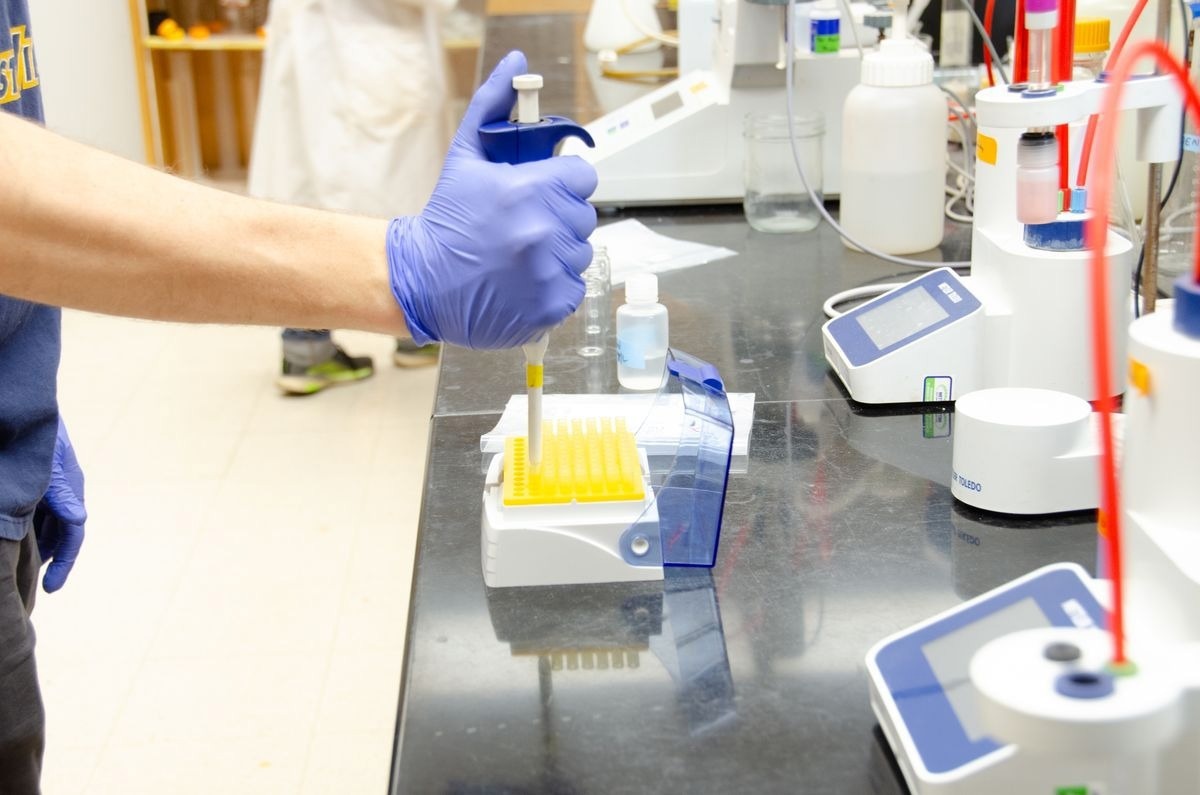The utilization of two types of industrial wastewater to cleanse each other, as demonstrated by simulations by West Virginia University researchers, has the potential to reduce the overall water consumption of a power plant.

A WVU chemical engineering student analyzes water samples as part of research that uses two different forms of industrial wastewater to purify each other. Although the sample sizes are small, a new process systems analysis shows stakeholders, like power plant operators, what to expect when cotreatment happens at a much larger scale. Image Credit: WVU Photo/Paige Nesbit
The WVU Benjamin M. Statler College of Engineering and Mineral Resources researchers modeled several scenarios in which “produced water” and “cooling tower blowdown” are used to treat one another. Wastewater from thermoelectric power plants is known as cooling tower blowdown, whereas generated water is made during the hydraulic fracturing process used to extract natural gas and oil.
In addition to producing water that is clean enough to be utilized again for power plant cooling operations, the cotreatment process produces useful byproducts. The journal Desalination published the study’s conclusions.
Lead author Hunter Barber, a chemical engineering doctorate candidate from Fairchance, Pennsylvania, claims that the production of thermoelectric electricity requires more water than any other industry in the United States.
Our cotreatment process reduces demand for chemicals to soften wastewater. The treated water also has very high potential for reuse — treated water can be directly reused after cotreatment to make up 99% to 100% of the original volume of blowdown water, and that’s without optimizing or exploring different designs.
Hunter Barber, Doctoral Student, Chemical Engineering, Benjamin M. Statler College of Engineering and Mineral Resources, West Virginia University
Power plants now take fresh water from a source of surface water or groundwater, cycle it to produce steam and electricity, and then slightly cleanse it before returning it to the water source.
Barber added, “Our approach is looking to close that cycle. Instead of discharging the water, we treat it, and instead of drawing from fresh water, we recycle treated water back through.”
Using generated water, the greatest wastewater output by volume in the oil and gas sector, they are lowering the quantity of purifying chemicals required to treat the cooling blowdown of the power plant. Reintroducing generated water from hydraulic fracturing directly back into the ground is one approach used today.
“In the Southwest especially, but also in the Marcellus Shale and Appalachian regions, you have oil and gas wells drilled deep into the ground. Once you pull all oil and gas from a well, it’s just an open cavity in the earth. You have polluted produced water that will take a high effort to treat or you can inject it back in that reservoir. However, injecting it involves seismic activity risk and contamination risk from heavy metals leaching into the ground,” Barber added.
The cotreatment procedure was developed under the direction of co-author Lian-Shin Lin, a professor and chair of the Wadsworth Department of Civil and Environmental Engineering. He made the argument that generated water had more salt in it than seawater.
Treating or disposing of that water is difficult and expensive. And an energy producer’s business is focused on producing shale gas and oil — they don’t want to care about water. It is a liability for them.
Lian-Shin Lin, Study Co-Author, Professor and Chair, Wadsworth Department of Civil and Environmental Engineering, West Virginia University
Lin added, “This cotreatment scheme offers a way to manage produced water and recover resources from it. For the energy industry that means, essentially, their produced water problem can disappear.”
Produced water from a nearby shale gas well and cooling tower blowdown from the Longview Power Plant are used in Lin’s experiment. Fernando Lima, associate professor of chemical engineering, stated that they saw a need for a techno-economic, environmental, and process systems analysis that would “scale the cotreatment concept up as much as possible, so it can be integrated into power plants or other wastewater treatment solutions and optimized with regard to operating costs, capital costs, and energy utilities” because the experimental samples Lin uses are small in comparison to the volume of water a power plant requires.
The researchers have been able to assess several wastewater treatment methods before attempting them in the lab and take into account modifications to power plant design and construction using process modeling. The economics and technical elements of cotreatment can be optimized through simulations for various treatment procedures.
Lima stated, “Collaborative research joining process modeling and experimentation is critical for the future of wastewater treatment because not a lot of detailed work has been done in modeling and optimizing these cotreatment processes, which involve very specific water chemistries that aren’t simple to capture.”
According to Barber, their model shows several benefits for power plants considering wastewater cotreatment.
Barber concluded, “A power plant likely already has dedicated personnel and equipment for treating its cooling blowdown. By becoming self-contained, they no longer have to draw from a water source. When they close the cycle, they no longer have to deal with potential negative economic consequences from discharging water that wasn’t clean enough according to EPA regulations. Instead, they can utilize the waste to make something beneficial and cost-effective. In terms of progressing the sustainability of many of our water demands, I think blowdown reuse is on the horizon for a lot of these facilities.”
Journal Reference
Barber, H, et. al. (2023) Synergistic cotreatment of cooling tower blowdown and produced waters: Modeling strategies for a comprehensive wastewater treatment simulation. Desalination. doi:10.1016/j.desal.2023.117003.
Source: https://www.wvu.edu/